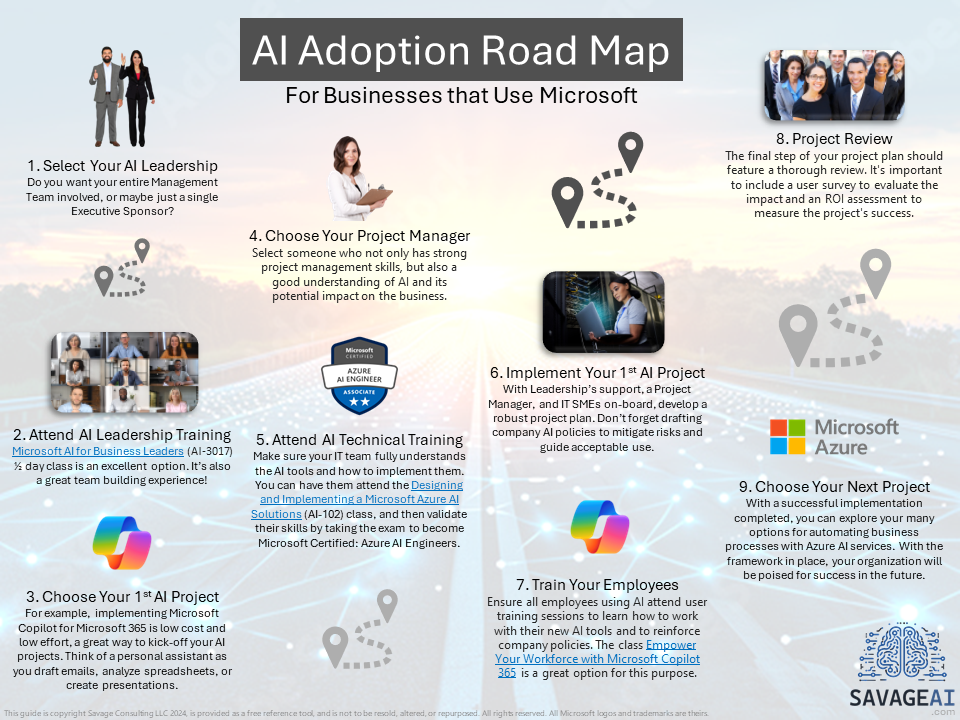A Comprehensive Guide
Free PDF download of the AI Adoption Road Map.
Artificial Intelligence (AI) is transforming industries by enhancing efficiency, driving innovation, and providing a competitive edge. For business leaders and professionals, understanding how to effectively implement AI is crucial. This guide outlines a streamlined approach to AI adoption, ensuring your business can harness the full potential of this powerful technology.

1. Understand and Identify AI Opportunities
Before diving into AI, it’s essential to understand the landscape of AI tools and technologies. Familiarize yourself with popular AI applications such as chatbot and integrated automation tools. These tools often address common business challenges across various industries, making processes more efficient and effective.
Tip: Instead of focusing on identifying specific business problems, consider exploring widely-used AI tools that can bring immediate benefits to your operations.
2. Develop a Strategic AI Roadmap
Create a clear and strategic AI roadmap that aligns with your business goals. This roadmap should outline both short-term and long-term objectives, key milestones, and performance indicators. A well-defined plan helps in tracking progress and ensuring that AI initiatives are on the right path.
Tip: Choose a steering team to investigate and select the right AI tools, and a proven project manager to champion each initiative. Educate these employees on the tools to ensure informed decision-making.
3. Build a Robust Data Foundation
AI thrives on high-quality data. Ensure your organization has a solid data infrastructure in place, with robust data governance practices to maintain data quality and integrity. This foundation is critical for training AI models and achieving accurate results. Your IT department plays a crucial role in this process, requiring readily available education to integrate existing systems and data into new AI tools while maintaining good AI policies and guardrails.
Tip: IT needs to integrate existing systems and their data into these new AI tools, while maintaining good AI policies and guardrails.
4. Foster a Culture of AI Adoption and Invest in Talent
Educating your workforce is key to successful AI implementation. Both AI users and IT professionals need comprehensive training. For users, instructor-led classes are highly effective in building AI literacy and confidence. IT professionals, on the other hand, need to understand how to deploy and manage AI tools effectively. Many businesses already have skilled staff and IT teams; involve them in the AI adoption process and ensure they receive the necessary education. They already know your business well and can provide valuable insights.
Tip: Ignite enthusiasm by highlighting AI’s transformative power and your commitment to equipping the team with cutting-edge tools, guidelines, and training. Remind them that embracing AI keeps us relevant and competitive, driving our business forward.
5. Start with Proof of Concept (PoC)
Begin with small-scale pilot project to test the feasibility and effectiveness of AI solutions. A good PoC provides valuable insights and will allow you to refine your approach before scaling up. Use the learnings from these pilots to inform larger AI initiatives.
Tip: Choose a PoC project that has a clear, measurable outcome that demonstrates AI’s value. For example, consider implementing Microsoft CoPilot, which is already integrated into Microsoft Windows and Office 365.
6. Seamless Integration and Deployment
Plan for the seamless integration of AI solutions with your existing systems. Ensure that your infrastructure can support AI applications and that data security measures are in place. Thorough testing is crucial before rolling out AI solutions to end-users.
Tip: Collaborate closely with your IT department to address any technical hurdles during integration.
7. Continuous Monitoring and Optimization
AI implementation is not a one-time effort. Continuously monitor the performance of AI solutions and make necessary adjustments to optimize their effectiveness. Regular reviews and updates ensure that AI tools remain aligned with business goals and adapt to changing needs.
Tip: Establish a feedback loop with end-users to gather insights and improve AI applications.

Free PDF download of the AI Adoption Road Map.
Example of a Common First Implementation
For example, more than 70% of organizations worldwide utilize Microsoft products and services. Microsoft has been working on AI for decades and was a major development partner with OpenAI, the power behind the popular ChatGPT. What many do not realize is that if they are already a Microsoft shop, then implementing Microsoft CoPilots into their existing systems is the wisest choice as it ensures the best policies and ROI. And Microsoft Azure AI solutions go beyond providing chatbots. From face and object recognition in video feeds, to reading and processing paper forms, Microsoft is at the forefront of AI solutions just waiting to be implemented by your organization.
Explore Live Instructor-Led Classes
To augment this roadmap, I invite you to explore my live instructor-led classes tailored for three key audiences: business leaders, IT staff, and AI users. Educating these groups ensures a comprehensive understanding of AI, enhancing the overall adoption process.
By following these steps, businesses can effectively navigate the AI adoption journey, leveraging AI to drive efficiency, innovation, and growth. This guide serves as a roadmap for business leaders and professionals, providing a structured approach to integrating AI into their operations.
For more insights and resources on AI adoption, visit SAVAGE AI.


